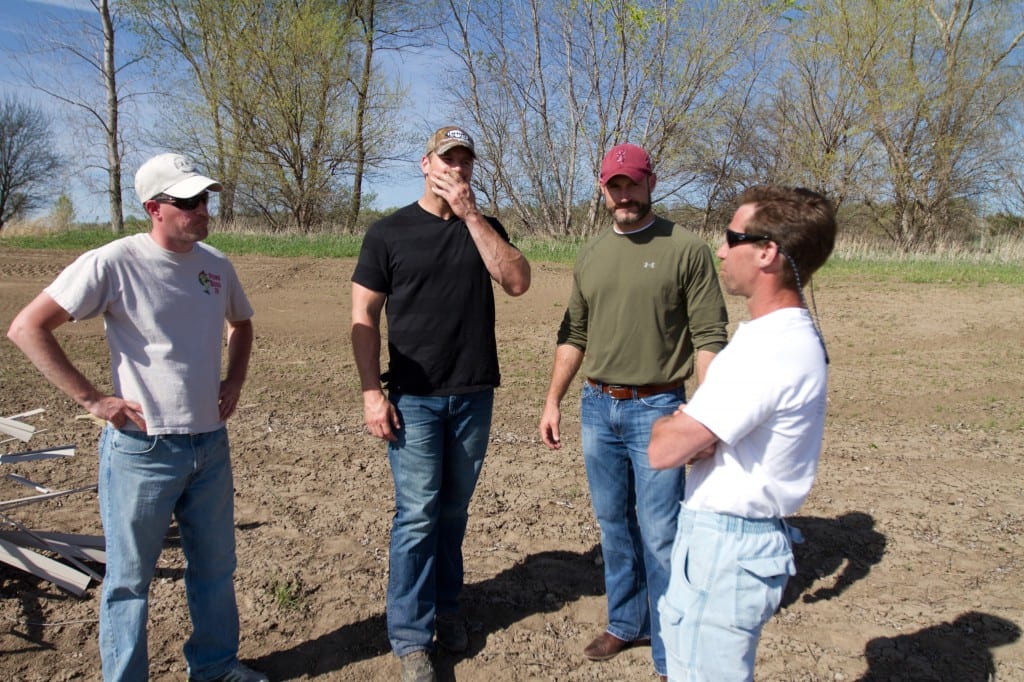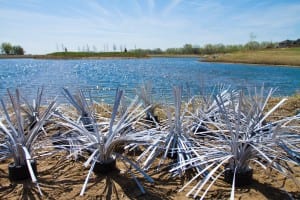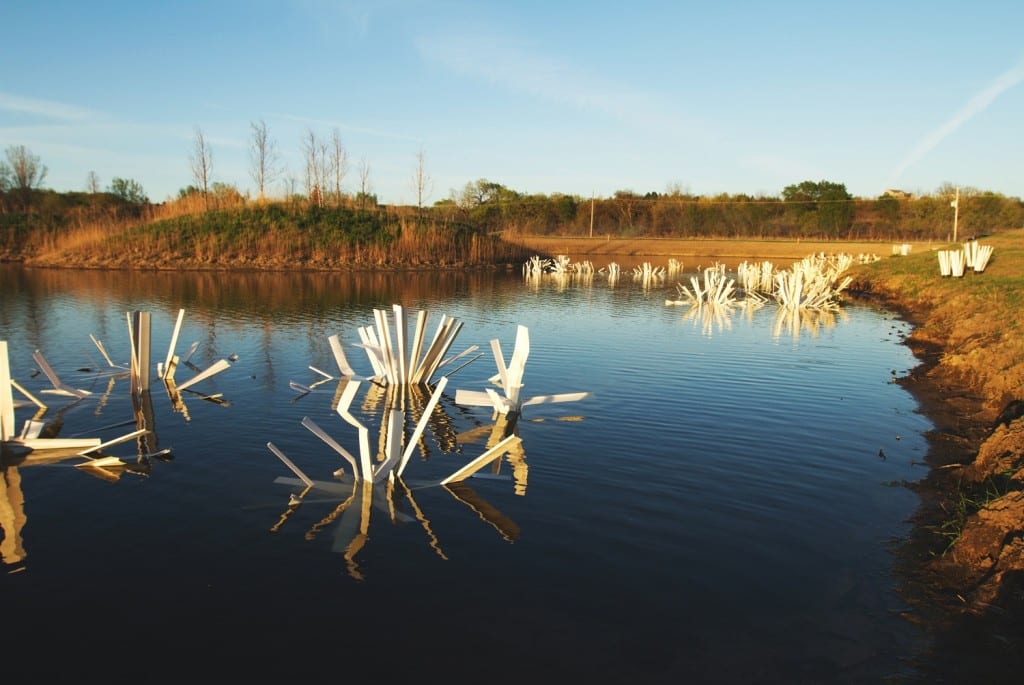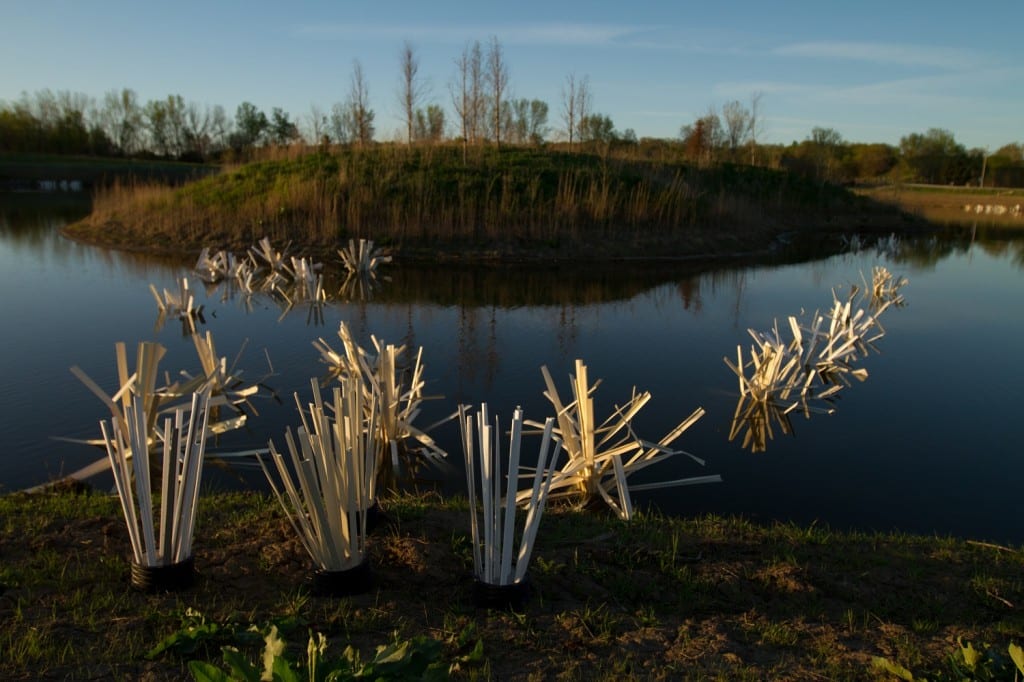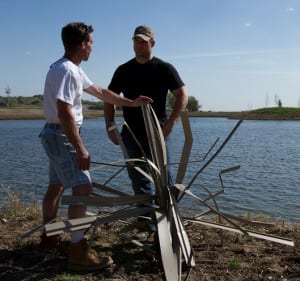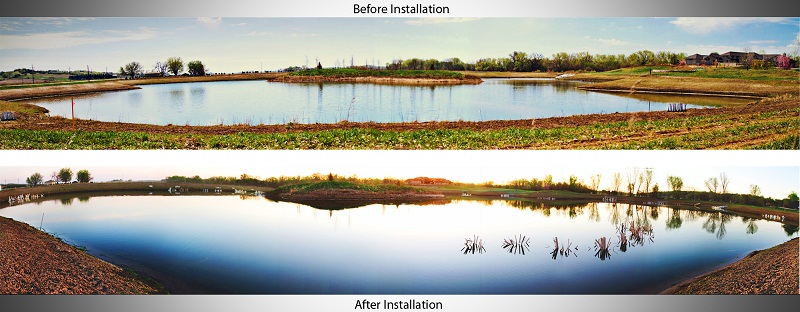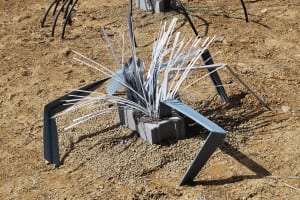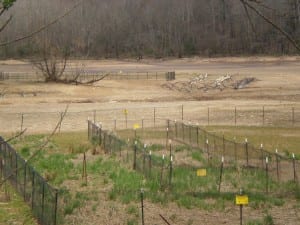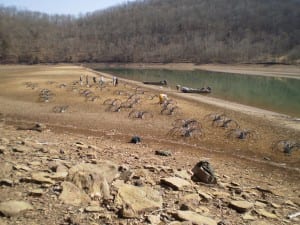| Vince Lovato Editor WASHINGTON, DC – Federal legislation now requires the Army Corps of Engineers to address the safety risks of placing dead trees in Lake Chelan to offset the environment damage allegedly caused by building a dock. The House Appropriations Committee passed a bill April 25 that requires the Corps to address the safety risks to recreational users of woody debris placed in Lake Chelan, according to U.S. Rep. Doc Hastings (R-Wenatchee). “Individuals wishing to construct a residential dock must pass through an exhaustive and very expensive permit process,” wrote boating safety instructor Russ Jones in a guest column to The Mirror. “Yet any agency wishing to deposit non-native species into the lake appear to be able to do so without the simplest of review processes. This was also the case with the use of submerged fruit trees. No prior study was conducted nor has there been any follow up study.” With the dramatic rise and fall of the water level through the different seasons, local residents have raised concerns about the possible movement of this woody debris and the safety hazards that it poses to boaters and other recreational users of the lake, Hastings said. “Washington residents have enjoyed waterskiing, swimming, boating and fishing in Lake Chelan for generations, and it is critical that it remain a safe environment for recreation,” said Hastings, who contributed language in the bill, “I am pleased that the Appropriations Committee acknowledges the need for the Corps to address the safety hazards of woody debris in Lake Chelan and reevaluate its use in the future so Lake Chelan can remain a safe place for Washington families to enjoy recreational activities. Additionally, I question the science and lack of monitoring of large woody debris as a mitigation requirement.” In January 2011, Chelan City Council members unanimously adopted a complicated resolution restricting the use of large woody debris as an environmental offset to construction projects such as boat docks over the lake. “In layman’s language, it would allow large woody debris but only low enough where it won’t interfere with boaters,” said council member Wendy Isenhart at that time. “It’s our responsibility to make policy here and we need an expression of our policy.” Chelan County Commissioners followed shortly thereafter with a similar resolution. Hastings’ language, which was included in the report accompanying the Fiscal Year 2013 Energy and Water Appropriations bill, requires the Army Corps of Engineers to report back to Congress on their efforts to address the safety hazards posed by woody debris in Lake Chelan, the liability of the Corps and private dock owners should a person or property be injured or destroyed by the woody debris, and whether woody debris should continue to be an acceptable option offered for mitigation within Lake Chelan. In March, Hastings, who has long questioned the need to mitigate the impact of docks on fish, submitted a request to Administrator Lubchenco of the National Oceanic and Atmospheric Administration for the science used to determine the impact of docks on fish species. Lubchenco has yet to respond to this request. One prescribed method is to anchor apple trees, referred to as large woody debris, near the shoreline to create artificial fish habitats. The Army Corps of Engineers and the State Department of Ecology created a prospectus that includes research allegedly proving this method would work in Lake Chelan. The agencies call the trees “large woody debris” and fear that every time a portion of the lake is covered by such things as docks, it has a negative impact on the ecology of the lake. Making up for that negative impact, by tethering dead trees near the lake shoreline to create habitat for fish, is called “mitigation.” |
Tag: pvc fish attractors
Gulf rigs, structures on track to become Essential Fish Habitat
Gulf Council begins process to properly recognize value of artificial reefs
CORPUS CHRISTI, TX – A request to have the Gulf of Mexico Fishery Management Council begin the process of classifying rigs and other vital artificial reefs as Essential Fish Habitat (EFH) was unanimously approved by the Council at its April meeting in Corpus Christi, Texas. Dr. Bob Shipp, Council member from Alabama and chairman of the Department of Marine Sciences at the University of South Alabama, made the motion as part of an effort to protect those structures from a 2010 federal directive to summarily remove all non-producing energy structures within five years of the issuance of that directive.
“This action sets in motion an amendment process that could be huge in the battle to save these structures, many of which are covered in tons of living coral and form the basis of thriving ecosystems,” said Pat Murray, CCA president. “We greatly appreciate Dr. Shipp for bringing this important issue to the Gulf Council to emphasize how important these structures are to the marine environment, and to anglers and divers.” See the dozens of unique artificial fish habitat models, fish attractors and fish cover used at fishiding.com, the leader in proven science based, fish protection.
If artificial reefs are eventually designated as EFH, all federal agencies would then have to consult with NOAA Fisheries on federal actions that may adversely affect them. The number of required consultations could be considerable given the current rate of platform removals and installations and, despite these consultations, NOAA Fisheries could only make non-binding recommendations as to how to conserve the affected habitat.
“This is a significant part of the effort to elevate the importance of artificial reefs and save them from an ill-conceived federal order, but we have to continue to work this issue in Congress and with the Administration,” said Murray. “With the offshore season upon us, the realization of the impact of rig removal is only going to become more acute as anglers go offshore and discover that rigs they have fished for years are gone.”
In a misdirected response to the Gulf oil spill, the U.S. Department of Interior issued a directive in October of 2010 ordering that all non-producing rigs be plugged and any remaining structure removed. There are approximately 3,500 offshore structures in the Gulf of Mexico and the directive, known as the Idle Iron Policy, would immediately impact roughly 650 structures that have not produced oil or gas within five years of the directive issue date of Oct. 15, 2010.
Sen. David Vitter (R-La) and Rep. Steve Palazzo (R-Ms) have filed legislation that would prevent rigs and other structures from being summarily removed from the Gulf of Mexico, but both bills face a difficult road through the current Congress. NOAA Fisheries declaring artificial structures and rigs as Essential Fish Habitat is a significant addition to those legislative efforts.
Arizona B.A.S.S. Federation Nation adds more Fish Habitat
 |
| ‘Don McDowell and Chris Cantrell share a check for $12,600 for working on the state’s habitat project. A mold for a Reef Ball is in the foreground.’ Don McDowell |
Reefballs are making a significant impact – Efforts to enhance Arizona’s bass fisheries with man-made habitats received a big boost, when the Arizona B.A.S.S. Federation Nation (ABFN) was awarded a $12,600 grant. That money from Arizona Sportsmen for Wildlife Conservation (ASWC) will be used to assist Arizona Game and Fish (AGF) in making concrete Reef Balls.
See the dozens of unique artificial fish habitat models, fish attractors and fish cover used at fishiding.com, the leader in proven science based, fish protection.
Reef Balls are the Arizona chapter’s answer to the state’s lack of habitat in its fisheries. Made of 3/4 yard of concrete, a Reef Ball looks like a half-sphere of Swiss cheese, according to Chris Cantrell, AGF fishery manager. He added that ecosystems form in and around the balls, which were popularized for marine fisheries. ‘It’s really good habitat that’s there for a long time,’ said Cantrell. ‘A Reef Ball is thought to take more than 500 years of saltwater.’
Compare that to five to 20 years for most artificial habitat.
‘Money will be spent to create additional molds to allow bulk concrete purchases to mass produce Reef Balls in one fell swoop instead of hand-mixing the concrete,’ said Don McDowell, ABFN conservation director.
‘This will allow us to build 12 additional three-piece molds,’ he continued, adding that this is the first time that the organization has provided a grant for fish habitat.
‘Looks like our fish are getting much needed new furniture much sooner than we had hoped for,’ he continued. ‘Our deepest gratitude to the ASWC.’
Sometime this fall, Saguaro Lake probably will be the next fishery to receive Reef Balls, which ABFN volunteers will help build, load, offload and place. The first was Tempe Town Lake.
Other funding so far has included a $910 donation from Midweek Bass Anglers from the club’s Holiday Open.
‘Once we’re to the production phase, we can go anywhere,’ Cantrell continued. ‘The concrete, renting the forklifts, moving the habitat, getting volunteers — all of that will be the easy part. The hard part is getting the molds created.’
Lack of habitat in Arizona waters is the No. 1 limiting factor for anglers.
‘It’s like a bathtub out there,’ Cantrell said of Arizona’s impoundments.
‘We don’t have a renewable resource,’ McDowell added. ‘We have to babysit the fish. And we have to take care of the habitat before we can have the fish.’
Bass Master website
AZ Sportsman for Wildlife Conservation website
Arizona Game and Fish website
by Robert Montgomery
Lake Norman Fish Habitat Projects succeed with TBFN
New habitats for fish and osprey at Lake Norman
 See the dozens of unique artificial fish habitat models, fish attractors and fish cover used at fishiding.com, the leader in proven science based, fish protection.
See the dozens of unique artificial fish habitat models, fish attractors and fish cover used at fishiding.com, the leader in proven science based, fish protection.Jose Mundo, an employee of Lancaster Custom Dock & Lift Systems Inc., places sticks while “seeding” a new osprey nest about 25 feet above the water of Lake Norman on Thursday.
MORE INFORMATION
- New habitat for Lake Norman creatures
- Spotted bass, hybrids thrive in Lake Norman water
WANT TO HELP?
To volunteer with Saturday’s Lake Norman buttonbush planting and other N.C. Wildlife Federation projects, visit www.ncwf.org or call Chris North, federation conservation director, at 704-332-5696. GPS coordinates for the rock reef sites are on the federation’s web site.
LAKE NORMAN Fishermen watched from boats as a trackhoe on a barge dumped 270 tons of boulders into Lake Norman Thursday, and a worker placed a manmade osprey nest 25 feet above the water on a sturdy wood pole.
The nonprofit N.C. Wildlife Federation led the initiatives in an ongoing effort to build habitat for wildlife, both fish and birds of prey.
“The more rock piles, the more habitat you put in the lake, the more (fishing) tournaments you have and the more money you generate for the local economy,” longtime Lake Norman fishing guide Gus Gustafson said. “There’s not enough rock piles to go around.”
Gustfason and other fishermen pulled nearby as trackhoe operator Ignacio Martinez of Lancaster Custom Docks and Lift Systems dumped rocks into 25 to 30 feet of water off the southern end of Brawley School Road peninsula in southern Iredell County. Other boulders were dropped farther north, near Lake Norman State Park in Troutman. The rocks came from a quarry in Denver, N.C.
The boulders are intended to create habitat for catfish, spotted and largemouth bass and other prized catches at the bottom of North Carolina’s largest lake.
By Friday morning, the fishermen knew, shad, herring and other bait fish would cluster at the rocks for protection from the larger fish, which in turn become unsuspecting catches for rods and reels.
“It’s the same as how people congregate at the opening of a new mall,” Gustfason said.
The federation led the rock dumping for the second year in a row. In 2011, Lancaster trackhoes plopped 270 tons of boulders at two other locations on the lake, creating fish habitat on the lake’s otherwise sandy bottom.
Fishermen previously established habitat by tossing Christmas trees into the lake, but the trees rot in a year, they said.
In 2009, federation volunteers also placed 200 porcupine-like “fish attractors” in the waters north of the N.C. 150 bridge and 100 attractors in Mountain Island Lake. They’re still there, attracting fish and anglers, said Tim Gestwicki, federation executive director.
On Thursday, volunteers from the federation and its Lake Norman Wildlife Conservationists chapter also peered skyward as a harnessed-in Jose Mundo placed sticks on a platform made of chain-link fencing and galvanized steel tubing to form an osprey nest.
“The birds will drop their own sticks onto the platform and then weave them all together,” said Stephen Turley, a federation board member who built the nesting platform at his Lake Norman home and six other platforms to be placed on the lake this year.
The federation has placed nearly 50 osprey platforms over the years at lakes along the Catawba River chain, from Lake James to Lake Wylie, Gestwicki said. He said a 2011 survey revealed 50 pairs of osprey nesting on Lake Norman alone.
The federation also plans to add two great blue heron rookeries on Lake Norman this year. On Saturday, its volunteers will plant 1,000 buttonbush plants at seven locations on Lake Norman islands, wetland areas and shoreline to slow erosion. The plant’s white flowers benefit hummingbirds, butterflies and honey bees, and its seeds provide food for wood ducks, mallards and migratory teal.
In 2011, the federation provided $100,000 for Mecklenburg County to preserve land at Mountain Island Lake.
Duke Energy’s Habitat Enhancement Program fund paid for the federation’s initiatives. Proceeds from dock and other fees help pay for the program, which has awarded $433,000 to projects in the Carolinas since it began in 2007.
United We Stand—In Support of Fish Habitat
 The new box culvert and open channel to Long Island Sound, which restored fish passage and tidal flows to the salt marsh. Volunteers installed the dune grass plantings.
The new box culvert and open channel to Long Island Sound, which restored fish passage and tidal flows to the salt marsh. Volunteers installed the dune grass plantings.We have a lot to learn from nature about teamwork. In fact, natural systems prove time and again that the intricate partnerships between air, water, soil, nutrients and plant and animal species breed success. So why, whether a singular agency, organization or landowner, would we ever think that we could “fix” a problem like fish habitat degradation alone? See the dozens of unique artificial fish habitat models, fish attractors and fish cover used at fishiding.com, the leader in proven science based, fish protection.
Well, we’re not trying to do it alone anymore. Just this week, I was able to represent USDA’s Natural Resources Conservation Service (NRCS) and speak to a nationwide group of conservation partners about how we follow nature’s lead and partner for impact.
We were gathered at The Nature Conservancy headquarters to celebrate the Memorandum of Understanding between the Departments of Agriculture, Commerce and Interior to implement theNational Fish Habitat Action Plan (NFHAP). This is a plan that leverages partnerships for collaborative, science-based conservation that yields results for species recovery and sustainability—a priority for NRCS.
NFHAP steers federal resources towards voluntary conservation strategies developed by grassroots fish habitat partnerships. The plan works by combining federal, state and private funding sources to achieve the greatest impact on fish populations through priority conservation projects.
Last spring in Long Island Sound, we and our partners restored tidal flow to a 78-acre tidal marsh by removing metal culverts—barriers to fish passage—and reconnecting 3 miles of stream to Bride Lake, a lake that now provides spawning habitat for river herring. In the second operating season, an electric fish counter recorded almost 197,000 river herring passing through the newly opened channel.
This project was a huge success thanks to the partnership efforts of the Connecticut Department of Energy & Environmental Protection, U.S. Fish & Wildlife Service, National Oceanic and Atmospheric Administration and Connecticut Fund for the Environment: Save the Sound.
 The small alewife species of herring swimming up the newly opened channel to spawn in Bride Lake.
The small alewife species of herring swimming up the newly opened channel to spawn in Bride Lake.This is only one example of the hundreds of ongoing projects fostered through the National Fish Habitat Partnership action plan. And NRCS is pursuing many exciting opportunities like this every day. The partnership approach stretches public dollars further because it engages the private sector in helping tackle shared priorities while connecting local conservation partnerships to achieve the best possible results. By combining resources we are increasing “boots on the ground” in priority areas to make a measurable impact.
Today, I followed up with our partners to outline the upcoming actions NRCS is taking on both the east and west coasts in support of the partnership. In Puget Sound, on Washington’s coast, we are making additional commitments to protect and build habitat for the Pacific salmon. In Long Island Sound, we are making resources available for efforts to restore shellfish habitat and oyster populations decimated during hurricane Irene.
At NRCS we are about not just the health of soil, air and water, but also the living ecosystems that make our natural resources so significant. Working lands and living waters create natural partnerships between the communities of sportsmen, agriculturists, environmentalists and wildlife enthusiasts. There is a place in nature for all of us to come together—starting with conservation partnerships! Posted by NRCS Assistant Chief James Gore
ASA: Secretaries Salazar, Vilsack And Bryson Come Together To Improve Fish Habitat Nationwide
by Outdoor Hub News

The sportfishing industry applauds the Secretaries of Interior, Agriculture and Commerce who signed a Memorandum of Understanding (MOU) to promote interagency collaboration on the implementation of the National Fish Habitat Action Plan (NFHAP), a science-based partnership that seeks to protect, restore and enhance fish habitat on a range-wide scale. The agreement will streamline agency efforts and ensure that federal resources are employed in the most effective and efficient manner possible.
The NFHAP was established in 2006 in response to the declining condition of waterways and fish habitat across the country. Through 18 Fish Habitat Partnerships, federal, state, tribal, local and private interests collaborate to conserve and restore fish habitat. This non-regulatory initiative is the most comprehensive effort ever attempted to voluntarily conserve freshwater, estuarine and marine habitats nationwide.
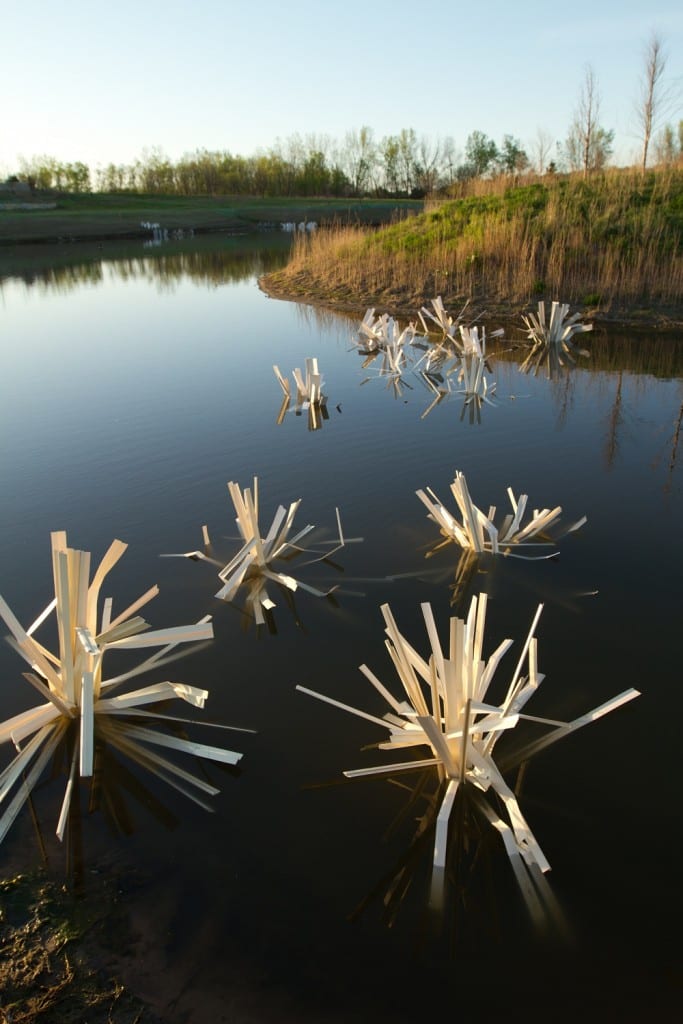
“The recreational fishing community is committed to the conservation and improvement of our waterways and it is gratifying to see the Administration strengthen its commitment to the NFHAP as well,” said Gordon Robertson, American Sportfishing Association vice president. “Our aquatic resources play a large role in the quality of our lives. Healthy waterways and robust fish populations are vital to the well-being of our society and sustainable fisheries, providing recreation, clean water, food and more.”
“This is a big step for our federal partners, who see the value of our strategic approach to conserving fish habitat,” said Kelly Hepler, chair of the National Fish Habitat Board who is also with the Alaska Department of Fish and Game. “Our coordination and involvement with federal agencies has really grown since 2006 and I think today marks a significant day in recognizing that.”
“The NFHAP not only conserves our waterways and fishery resources, it fuels a great economic engine,” said Mr. Robertson. “Recreational fishing has a $125 billion impact on our nation’s economy. The economic, social and conservation benefits of recreational fishing would not be possible without the commitment made by programs like NFHAP to ensure our nation’s waterways are clean, healthy and abundant with fish. Over the years, NFHAP has proven that a small federal investment will benefit all Americans and the resources that we depend on for livelihood and leisure.”
See the dozens of unique artificial fish habitat models, fish attractors and fish cover used at fishiding.com, the leader in proven science based, fish protection.
Between 2006 and 2010, the U.S. Fish and Wildlife Service provided $12 million to support 257 on-the-ground conservation projects in 42 states, leveraging $30 million in partner match, to address the priorities of the Fish Habitat Partnerships. This investment in turn creates jobs and provides economic benefits as results of healthier waterways and increased recreational fishing activity. Investment in the NFHAP since 2006 has generated nearly $1 billion in value and supported over 20,000 jobs. That is a return of over $20 for every dollar spent and one job supported by every $2,400 invested.
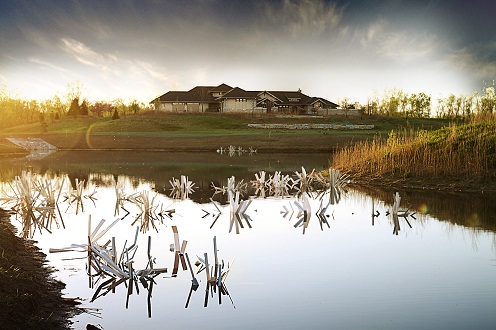
“Our next step is to have Members of Congress get on board with this important initiative,” said Mr. Robertson. “The National Fish Habitat Conservation Act (S.1201), introduced by Sen. Lieberman (I-Conn.), will formally authorize and establish a funding source for the NFHAP, providing much needed support for aquatic habitat restoration and conservation across the U.S. Together with the support of the Administration and Congress, we can expand upon the tremendous strides already made by NFHAP in restoring our nation’s waterways.”
NFL Player Chris Kelsay Tackles Fishing Lake Project in Nebraska
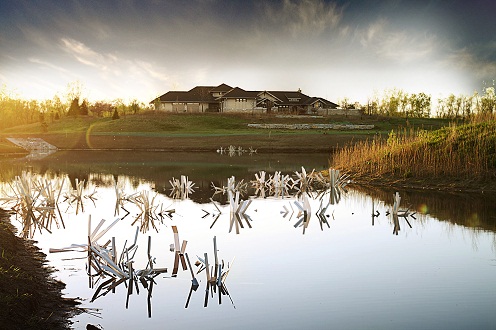
What kind of habitat helps the fish grow large and the water stay clear? Can you actually dictate where to cast your lure to find a bass lurking in the shaded cover like a defensemen reads a quarterback?
If you spend the time and effort to plan the design of your lake or pond from start to finish, you can achieve these goals and much more. Chris Kelsay, veteran linebacker/defensive end of the Buffalo Bills has a passion for more than just football. Chris not only loves to tackle running backs and wide receivers, but big bass are also on the hit list. Growing up in Nebraska, Chris has loved the outdoors all his life. When he’s not playing ball, he’s often talking fishing and hunting with his family and friends, planning his next adventure with his bow, firearms or fishing rods. Chris plays off the field with as much intensity as he does at work, stalking, sneaking and outsmarting his opponents with hard work and dedication.
Another NFL great that is no stranger to the outdoors is Aaron Graham, former Center for the Arizona Cardinals, Oakland Raiders and finishing up his career with the Tennessee Titans. These two guys have quite a bit more in common than playing ball in the NFL. Not only are they neighbors near Gretna Nebraska, but they both love to fish and hunt, having their own private lakes that they enjoy with their families and friends. Both these guys played college ball for the Nebraska Cornhuskers, as well as Chris’ brother Chad. Retiring from the NFL, Aaron now owns and operates his own company called “Premier Outdoor properties”, which specializes in large tract farm, ranch and recreational real estate throughout Nebraska, Kansas, Iowa and Missouri. Participating with Cabela’s Trophy Properties, his firm can help you find your dream hunting and fishing, farm and ranch, lake or river frontage, and large tract acreages, to meet any needs you may have.
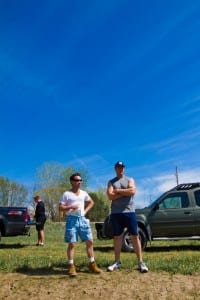
Aaron has had his lake stocked with an exceptional strain of bass, with catches to date over eight pounds by his son Cooper. With the lake being about seven years old, Aaron has a jump start on Chris with some experience in habitat, stocking and water quality. We met Aaron over a year ago, providing him with some of our artificial fish habitat products for his lake. Follow this link to read about aaron’s habitat project. The success he has had with our products, encouraged him to put Chris in touch with the team at Fishiding.com to discuss a plan for his first of two lakes, as it was getting ready to be filled to full pool. With a large well, levelor system, aeration and a stocking plan in place, we came up with a plan and design to meet Chris’ desire to create a personal, one of a kind fishery. The first lake Chris has on his property, at just over six acres, needs plenty of cover for the fish to spawn, hide and hunt within. A well known and respected fisheries biologist Bob Lusk of Pondboss.com, recommends at least 20% of the surface area of a lake or pond be provided in habitat.
See the dozens of unique artificial fish habitat models, fish attractors and fish cover used at fishiding.com, the leader in proven science based, fish protection.
With plans to include aquatic plants, wood and rock, we came up with an array of artificial habitat models to make up about 25% of the needed habitat for Chris’ first lake. We have always felt that a variety of natural and artificial habitat provides the diversity, all types of fish species need to utilize throughout the year. Like most things in life, everything in moderation seems to achieve the maximum efficiency and ultimate benefits for a fishery.
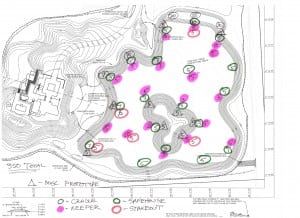
The plan we came up with provided an array of structure textures, sizes and shapes to best provide cover for fish spawning and growing habitats. A total of 350 individual habitat units were hand selected to best achieve Chris’ goals to create a trophy bass fishery. A key element to any habitat plan is to create a line of structure from shallow water spawning areas out to mid depth and ultimately deep water cover. This allows young fry to hide in fine, dense cover immediately after hatching, in the shallow water they are spawned in. As these young of the year fry develop and explore out to mid depth ranges, they need to have cover to utilize as they progress deeper. If this cover is not available, they get eaten before reaching preferred size by predator fish. It is imperative that these small fish are able to hide and grow larger to the 3″-5″ size before becoming forage for the game fish. A bass for instance, needs to eat 10 pounds of forage to put on just one pound in weight. If that bass eats the fry before they get large enough, he will eat them all up just to satisfy his hunger and desire to put on weight.
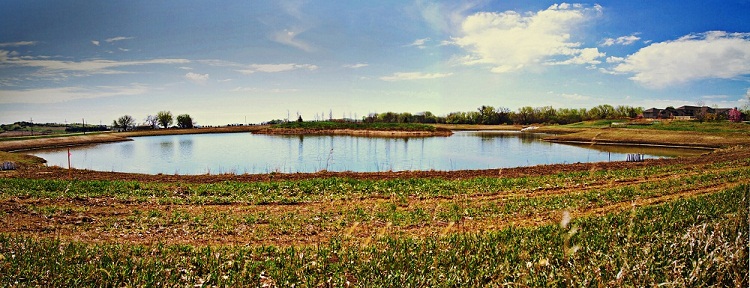
We put our plan together to deliver the structure and help Chris with the installation. Although artificial habitat only needs to be installed once, this was a large amount of structure to ship and install at one time. It was decided we would drive the almost 7200 pounds of habitat out in our own truck and trailer from our facility in northern Illinois. The 475 mile trip had us arriving by lunchtime on a Friday, with the hopes of finishing the installation late Saturday evening, for the return trip on Sunday.
Three of us set out at 4:00 a.m. Friday to achieve our goal. Our son Graham, an electronic media/photography major at Moody Bible Institute in Chicago, came to capture the project in high definition pictures and video and help with the installation process. Also along was our nephew Josh Fick, a starting player for the North Central college football team, over excited to meet and work with the NFL players. Meeting us there was Josh Milczski, a Nebraska native, writer for recycled fish.org, a pond boss moderator and Nebraska Fish and Game board member to lend a hand and share his knowledge. Also on hand to help was Chris and Chad Kelsay, as well as Aaron and Cooper Graham.
We unloaded all 350 units and spotted them around the lake per plan Friday afternoon and then when out for a well desreved Nebraska steak dinner to re-fuel for the big push on Saturday.
The weather was un-seasonably hot, with temps. in the low 90’s and full sun. None of us expected to be getting sun burn in march, let alone starting to find Morel mushrooms already. The turkey were gobbling on the roost as we set up for a long day of work, unfolding each unit and stocking them on the bank near their final resting place. Geese and ducks of all varieties, came in and out of the lake all day, giving us a show of the abundant wildlife in the area. There was about 2 feet of water existing in the lake from runoff and ground water level, an ideal situation to put our plan into motion.
Three Nebraska Boys and one flatlander plan the attack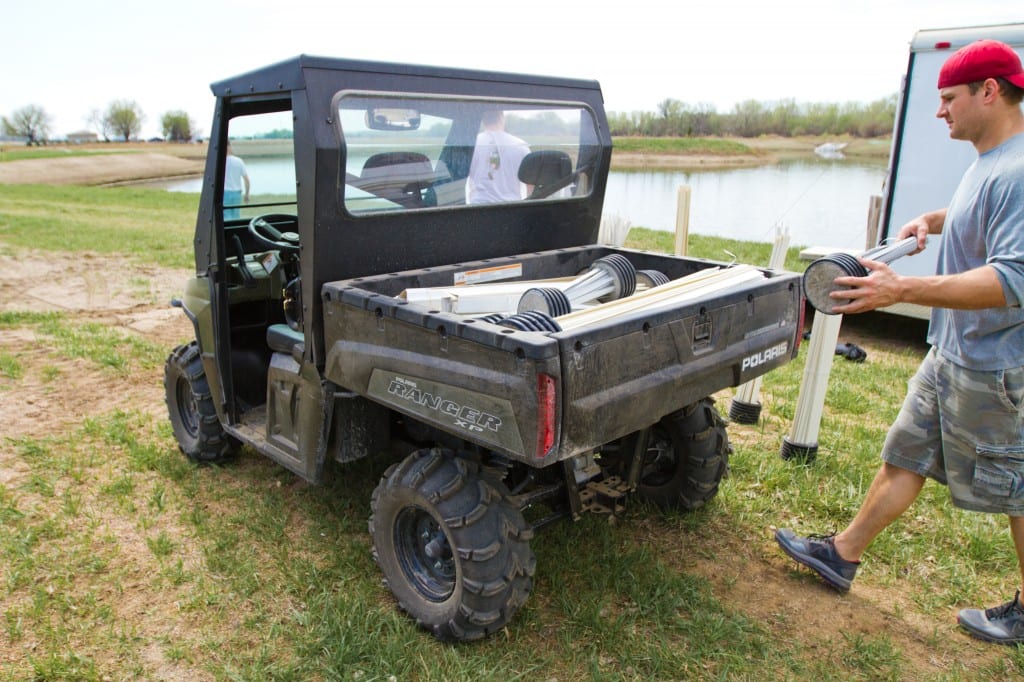
The “Kelsay express” saved lots of time
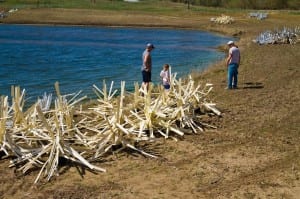
The Fishiding fish habitat products are all made from reclaimed PVC vinyl siding that was destined to be put in landfills. Over 50% of the material acquired has never been used on buildings and will last for many generations to come. This safe, inert substrate, works perfectly for underwater applications in fish habitat. Our main supplier of discarded siding comes from K. Hoving companies. This state of the art waste removal operation currently recycles an astounding 75% of the trash they collect. Re-use is the term they use to explain their company goals. See this story about their firm and the great things they are doing to help our environment. Add the cover and your fish will prosper, Go-Green and save the environment all at the same time.
All fishiding units come complete, ready to sink with no assembly or additional parts/tools needed. Simply open the box, bend to any desired shape and toss in the lake. Each unit sinks upright with the included “stump like” base. There is no incorrect or wrong shape, as diverse as Mother Nature. Artificial habitat products are being used all around the country, as biologists learn more about the many advantages they offer. Years of use from these structures allow anglers and pond/lake owners a snag free habitat for fish to utilize. Saving the environment, these fish attractors help conserve energy with no manufacturing process involved.
Cleaned, cut into various shapes, widths and sizes then cemented into just about any type of safe container, fishing groups are getting involved in creating new habitats lost from degradation and development. All of the fishiding models are available shipped loose as well as in a completed form. Customers can save money by purchasing loose pieces of the PVC in all varities and create their own custom designs by using their own container and cement. A special mixture of cement is also available to ensure a tight, fool proof bond to the vinyl. The pieces and models come in an array of colors, just like the colors available when siding your new home. After the algae and bio film begins to grow, they all take on a greenish/brown appearance.
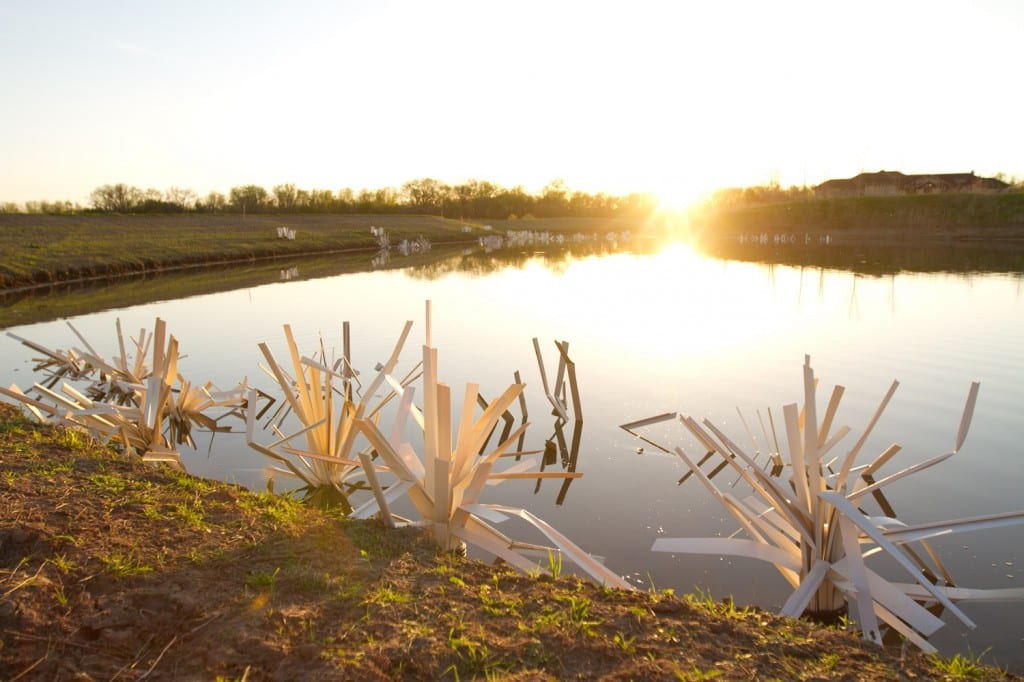
Groups like the B.A.S.S. Federation Nation have begun to incorporate Fishiding habitat products into their ongoing conservation efforts. Projects in West Virginia were recently completed with great success. Plans to work in New Mexico, South Dakota,Virginia and Texas are being put together currently with the conservation directors in those states. The B.A.S.S. Federation Nation leads the industry by example in conservation work with groups in all states and Canada promoting conservation and water quality issues world wide.
Lake and pond owners enjoy the ease of installation, with no need to ever replace. The limbs all have any holes or notches removed to make each unit snag resistant,unlike brush and Christmas trees. By providing shallow habitat for fry and forage fish, mosquitos can be almost eliminated in the area, as they feed on these pesty critters. Shallow habitat is the key to growing your own forage base, thus eliminating the need to constantly restock minnows to feed your game fish.
100 Keeper models were incorporated into the plan for deep water structure. These large units each boast over 62 square feet of surface area and allow predator fish to hunt and hide around. When opened and bent to shape, they cover a seven foot diameter and are best installed with about a foot of space in between. This allows fish to navigate through them, feeding and resting in the shade they produce. Bass prefer the dense cover and shade that these fish attractors provide.
Also part of the plan was to install 25 Stakeout structures, which are artificial stake beds, crappie and bluegill fisherman use a great deal in the south. These units stand 48″ tall and have an open grouping of individual “sticks” that the panfish prefer. Another 50 smaller prototype versions of these were installed in shallow areas for young of the year fish to navigate through as well.
See the dozens of unique artificial fish habitat models, fish attractors and fish cover used at fishiding.com, the leader in proven science based, fish protection.
With all the help and planning, we were able to meet our goal and finish installing all 350 Fishiding habitat units by sundown on Saturday. Chris welcomed us into his beautiful home and surrounding landscape. Although we had no time to hunt or fish while we were there, plans are being made to come back to install our habitat products in his second, five acre lake. With common goals of preserving our natural surroundings and creating a fantastic fishery, we are planning to spend some time together in the great outdoors with bows, guns and fishing rods in hand. New friendships have been made, stories of the hunt continue to be shared and the love of the great outdoors continue to be the catalyst for a common bond between men from all walks of life.
625 Scientists Oppose Fisheries Act Changes to Habitat Protection
The scientists believe that removing the habitat protections would jeopardise many important fish stocks and the lakes, estuaries and rivers that support them.
“Weakening habitat protections will negatively impact water quality and fisheries across the country, and could undermine Canada’s attempt to maintain international credibility in the environment.”
Since the plans were first revealed, they have come under constant criticism from the industry and others who believe that changes will facilitate approvals for oil sands projects like the Enbridge Northern Gateway pipeline. See the dozens of unique artificial fish habitat models, fish attractors and fish cover used at fishiding.com, the leader in proven science based, fish protection.
The letter states that fish habitat is the most common reason for species decline.
Concluding the scientists said that all species are of ecological value, referring to the government’s plans to only protect fish habitat for “fisheries of economic, cultural and ecological value.”
“It is critical that any changes do not jeopardise the environmental support system on which we and future generations depend.”
TheFishSite News Desk
WVBFN leads by example for the B.A.S.S. Federation Nation with Fishiding artificial fish habitat
 If you want to grow and sustain your fishery, then you have to expand the habitat for fish to reproduce and grow large. This is nothing new for the fisherman involved in the B.A.S.S. Federation Nation of West Virginia. These guys have been involved in habitat restoration projects from the beginning, leading the way for future generations of fish and fisherman to grow and prosper.
If you want to grow and sustain your fishery, then you have to expand the habitat for fish to reproduce and grow large. This is nothing new for the fisherman involved in the B.A.S.S. Federation Nation of West Virginia. These guys have been involved in habitat restoration projects from the beginning, leading the way for future generations of fish and fisherman to grow and prosper.
A few short weeks ago, Jerod Harman, Conservation Director for the West Virginia B.A.S.S.Federation Nation, contacted the owner of Fishiding artificial habitats. Jerod saw the benefits of these reclaimed PVC structures and asked about working together to help them in their ongoing efforts to improve fish habitat on a few of their local lakes.
See the dozens of unique artificial fish habitat models, fish attractors and fish cover used at fishiding.com, the leader in proven science based, fish protection.
Fishiding habitat products had been recently been awarded at the Bassmasters Classic Conservation Summit in Shreveport,LA. Jerod, a long time steward of B.A.S.S knew these reclaimed structures would help achieve their habitat goals, complimenting the “Spider Blocks” he is so well known for installing. Jerod has a long time relationship with local Corps of Engineer leaders and the DNR in his outstanding state. Having worked with them for many years on multiple restoration projects, his reputation is well known for rounding up the troops and getting the job done in an utmost professional and timely manner. Field and Stream magazine has also highlighted his work in a recent issue, honoring him as one of our Nation’s “Hero’s of Conservation” for his habitat work.
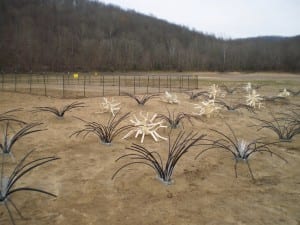 When the local lakes are drawn down for the winter, Jerod and his dedicated team of volunteers spring into action when most of us are sitting by a warm fire. The exposed lake bed gives them the opportunity to get right into the fishes’ favorite breeding grounds and begin to work their magic. In past years, the group has braved snow, ice and freezing temperatures to work on structures to provide habitat that is either lacking, has deteriorated or washed away by flooding. The group typically works with artificial structures that will last for many years to come, since they never rot or decompose like other types of natural products. They also install native plants and protect them from predators until they have a chance to take hold.
When the local lakes are drawn down for the winter, Jerod and his dedicated team of volunteers spring into action when most of us are sitting by a warm fire. The exposed lake bed gives them the opportunity to get right into the fishes’ favorite breeding grounds and begin to work their magic. In past years, the group has braved snow, ice and freezing temperatures to work on structures to provide habitat that is either lacking, has deteriorated or washed away by flooding. The group typically works with artificial structures that will last for many years to come, since they never rot or decompose like other types of natural products. They also install native plants and protect them from predators until they have a chance to take hold.
Jim Summers is another name synonymous with habitat. Jim has worked on these types of projects for many years and now takes credit for the fine photos we have to enjoy. Jim is always on hand to help, as well as get the shots as the work progresses. Some of the WVDNR staff put on their wet suits on their own time to get the underwater pictures of the spider block structures after they had time to age. The proof is in the pictures, showing not only bass, but forage species utilizing the new habitat the group has provided and installed.
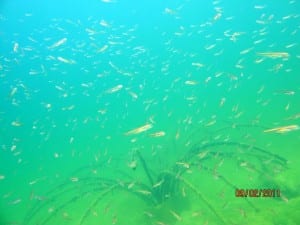
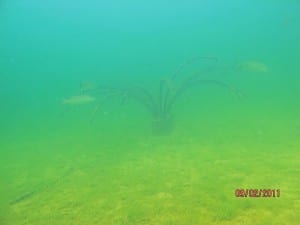 The key to the effectiveness of artificial fish habitat, is the ability to grow bio film or periphyton. This film forms on inert substrates and begins the cycle of life which attracts invertebrates and larger fish to feed on. Other aspects that hold these types of structure units above the rest is that they don’t decompose, therefore not using up important dissolved oxygen from the water column as they rot. Bio film is proven to be the highest form of fish food, better than any commercial feeds on the market today. The bio film consumes over abundant nutrients like phosphorous, brought in by runoff which causes excessive algae growth in many lakes and ponds. The fish then eat this high energy food and grow even larger, at an unmatched rate to boot! A company leading this technology is Floating Islands International,Inc out of Montana. These islands made from recycled plastics form a matrix of fibers, creating maximum surface area to grow this bio film. Not only do these products feed the fish, but they cleanse the water and drastically improve water clarity.
The key to the effectiveness of artificial fish habitat, is the ability to grow bio film or periphyton. This film forms on inert substrates and begins the cycle of life which attracts invertebrates and larger fish to feed on. Other aspects that hold these types of structure units above the rest is that they don’t decompose, therefore not using up important dissolved oxygen from the water column as they rot. Bio film is proven to be the highest form of fish food, better than any commercial feeds on the market today. The bio film consumes over abundant nutrients like phosphorous, brought in by runoff which causes excessive algae growth in many lakes and ponds. The fish then eat this high energy food and grow even larger, at an unmatched rate to boot! A company leading this technology is Floating Islands International,Inc out of Montana. These islands made from recycled plastics form a matrix of fibers, creating maximum surface area to grow this bio film. Not only do these products feed the fish, but they cleanse the water and drastically improve water clarity.
 Generally, the group of volunteers will install 50-75 habitat units per outing. Much of the supplies are donated by local companies, providing pipe, cinder blocks and cement. Some of the funds are received from state and federal grants, to provide plant stock and professional help as well. The bulk of the effort comes from volunteer labor, provided by Jerod and his dedicated group of conservation minded members. Without folks like these, our grand kids would not have the opportunity to enjoy what we have been so blessed to enjoy for so many years.
Generally, the group of volunteers will install 50-75 habitat units per outing. Much of the supplies are donated by local companies, providing pipe, cinder blocks and cement. Some of the funds are received from state and federal grants, to provide plant stock and professional help as well. The bulk of the effort comes from volunteer labor, provided by Jerod and his dedicated group of conservation minded members. Without folks like these, our grand kids would not have the opportunity to enjoy what we have been so blessed to enjoy for so many years.
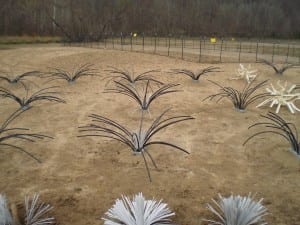 The most recent projects involving the donated fishiding structures were put in Lake Summersville and Sutton Lake. These two area lakes will benefit in many ways from the Federation’s efforts. Spider Blocks, along with Keeper, Safehouse and shallow Cradle models all work together near new bullrush and arrow anum plantings to provide ultimate spawning areas.
The most recent projects involving the donated fishiding structures were put in Lake Summersville and Sutton Lake. These two area lakes will benefit in many ways from the Federation’s efforts. Spider Blocks, along with Keeper, Safehouse and shallow Cradle models all work together near new bullrush and arrow anum plantings to provide ultimate spawning areas.
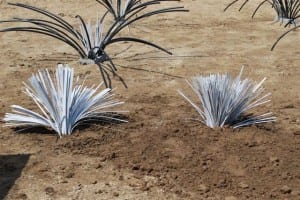 1800 plants were added to Sutton lake by volunteers from the WVBFN as well as local DNR officials and staff. David Truban, a West Virginia DNR commisioner was also on hand to bend a few Fishiding structures too. Jerod told Dave, “Just think like a fish and have at it” He was pleased to put his twist on making one into a fantastic looking block! ” I honestly believe that this project will make huge a difference in this area of the lake because of the diversity of habitat that they will have at theit disposal. “If I were a bass, this is where I would want to call home”
1800 plants were added to Sutton lake by volunteers from the WVBFN as well as local DNR officials and staff. David Truban, a West Virginia DNR commisioner was also on hand to bend a few Fishiding structures too. Jerod told Dave, “Just think like a fish and have at it” He was pleased to put his twist on making one into a fantastic looking block! ” I honestly believe that this project will make huge a difference in this area of the lake because of the diversity of habitat that they will have at theit disposal. “If I were a bass, this is where I would want to call home”
“I really don’t see us doing projects in the future without artificial structures mixed in. No matter what the weather conditions are, they are an investment that will be there through freezing, drought, high water, just about anything barring a massive flood in which they would be washed out. And even then, they will just be redistributed for cover somewhere else. ” Jerod Harman.
Working with the WVBFN has been an absolute pleasure. Cribs were sent out to the guys early in the week and by the weekend, they were in place ready for the water to rise. Others can take note of the dedicated members, the communities involvement and the ongoing positive relationship formed with the local governing agencies. These fish will prosper from their combined efforts, ultimately providing fisherman with a vast variety of cover and species to target.
For more information about the WVBFN and it’s affiliates you can go to their website at http://www.wvabassfederationnation.com . To get involved in their habitat efforts you can contact Jerod Harman at jharman12@cebridge.net
Detroit River fundraiser to highlight restoration projects
WYANDOTTE — Friends of the Detroit River extends an invitation to get together March 31 at the Wyandotte Boat Club for the annual Detroit Riverkeeper fundraising dinner.
The goal of the dinner is to raise funds to help support the Detroit Riverkeeper program and the patrol work that Riverkeeper Robert Burns does along the Detroit River.
The dinner will be held at the rowing club’s facility in the Wyandotte Boat Club’s second-story banquet room, which overlooks the Detroit River. The facility is at 1 Pine St, east of Biddle Avenue and south of Eureka Road, across from the Portofino restaurant parking lot.
Doors open at 6 p.m. for socializing, followed by a catered dinner at 7 p.m.
Friends of the Detroit River is a nonprofit organization dedicated to protecting and improving the waters and habitats along the river’s watershed.
After dinner, a presentation will be given on three Great Lakes restoration projects the group is working on along the Detroit River.
See the dozens of unique artificial fish habitat models, fish attractors and fish cover used at fishiding.com, the leader in proven science based, fish protection.
According to Burns, the group received $3.2 million in grants on behalf of the Detroit River Area of Concern’s Public Advisory Committee from the U.S. Environmental Protection Agency’s Great Lakes Restoration Initiate funds to do the projects. Two of them are on Belle Isle and one is along the shoreline of U.S. Steel-Great Lakes Works’ facility in Ecorse and River Rouge.
The first project on Belle Isle will be at the south fishing pier, just below the Coast Guard station, and will involve the creation of a fish habitat area behind the pier, along with some shoreline restoration.
The second Belle Isle project will be to open up the landlocked Blue Heron Lagoon lake, at the upper end of the island, to the river.
“This will allow fish from the river to be able to access this 40-acre shallow wetland lake, adding valuable fishing habitat for spawning and a nursery area for fish that hatch in the upper river,” Burns said.
The third project is between the Great Lakes Steel Boat Club and the 80-inch rolling mill on the U.S. Steel site. Burns said this shoreline has some natural features on a section of the site not being used by the facility.
“The project is currently proposing to enhance an existing 300-feet rock shoal that will provide additional fish habitat,” he said. “The shoreline will also be enhanced with emergent native vegetation, and about five acres of upland area will be replanted with native trees, bushes and vegetation to provide habitat for local wildlife and migratory birds.”
All three projects are expected to begin by this summer.
The fundraiser will include a cash bar, music, a raffle and a silent auction. Advance tickets are $50 per couple, $30 for a single ticket and $15 for children.
“Come join us for a pleasant evening of networking and socializing,” Burns said.
For more information about the event and to purchase tickets, call 1-734-675-0141 or visitdetroitriver.org.By Jim Kasuba
